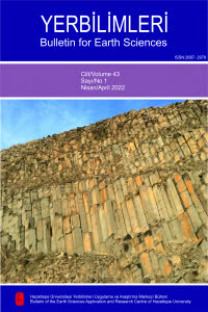Gömülü Jeolojik Yapıların Görüntülenmesinde Farklı Sınır Belirleme Yöntemleri
Jeofizik potansiyel alan verilerinin yorumunda, gömülü yapıların sınırlarının belirlenmesi oldukça önemli bir yere sahiptir. Anomaliye neden olan gömülü yapı sınırlarını belirlemek için, potansiyel alan vektör bileşenleri ve gradient tensörlerinden türetilen pek çok yöntem bulunmaktadır. Bu çalışmada, gömülü jeolojik yapıların görüntülenmesinde kullanılan farklı sınır belirleme yöntemlerinin tanıtımı ve performanslarının karşılaştırılması amaçlanmıştır. Bu yöntemlerin gerek incelenen yer altı jeolojik modeline ve gerekse birbirlerine göre, üstün ve zayıf yönleri bulunmaktadır. Bu nedenle, arazi verilerine uygulanmadan önce, pek çok karmaşık model için üretilecek sentetik veriler ile sınanmaları gerekmektedir. Ayrıca, "Gravite Gradient Tensörlerinin Toplam Yatay Türevi" olarak isimlendirilen, yeni bir sınır/kenar belirleme süzgeci tanımlanmıştır. Bu süzgeç, sığ ve yoğunluk kontrastı fazla olan yapı sınırlarını belirlemede başarılıdır.
Different Edge Detection Techniques for Imaging Buried Geological Structures
Imaging buried geological boundaries has an important role during the interpretation of potential field data of Geophysics. There are lots of techniques, which were generated from potential field's vector components and gradient tensors, to detect boundaries of the buried structure which causes anomaly. In this study, introducing the different edge detection techniques for imaging buried geological boundaries and comparing their performances were aimed. These techniques have advantages and drawbacks between each other and also depend on geological model below the surface. For that reason, they should be tested for the synthetic data from various complex models, before application to field data. Additionally, a new edge detection filter, named as Total Horizontal Derivative of Gravity Gradient Tensors, has presented. This filter is successful on detection of the boundaries of shallow structures and also the boundaries with high density contrast.
___
- ISSN: 1301-2894
- Başlangıç: 1976
- Yayıncı: Hacettepe Üniversitesi Yerbilimleri Uygulama ve Araştırma Merkezi
Sayıdaki Diğer Makaleler
Manyetotellürik Veri Üzerindeki Deniz Etkisinin İncelenmesi: Düzce Bölgesi Örneği
Fatih UZUNCA, S.Bülent TANK, Tülay KAYA, LEVENT GÜLEN
Küre (Kastamonu) Karmaşığı ofiyolitik kayaçları ve bu kayaçları kesen dasitlerin kökeni
Gömülü Jeolojik Yapıların Görüntülenmesinde Farklı Sınır Belirleme Yöntemleri
Merkezi Kompozit Tasarımı Kullanılarak Bakır Cürufundan Arsenik Liçinin İncelenmesi
Ceyda ÖZTÜRK, Cumhur Ö. KILIÇ, Taner ÜNLÜ
Hiperbolik Sekant Fonksiyonlar ile Analitik Çentik Süzgeç Tasarımı
